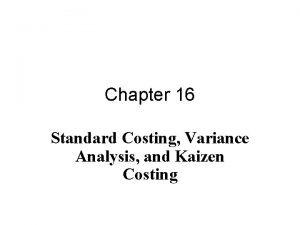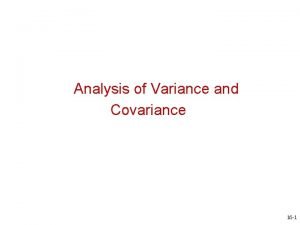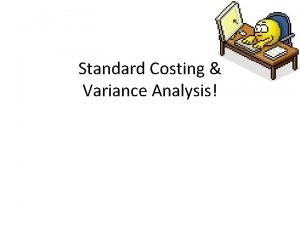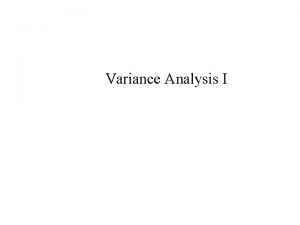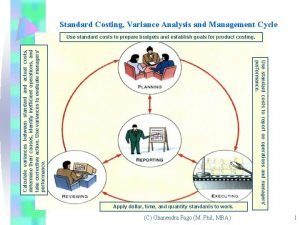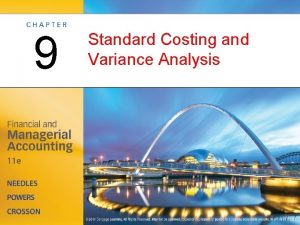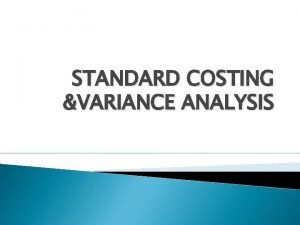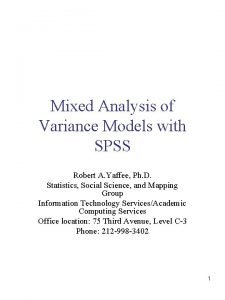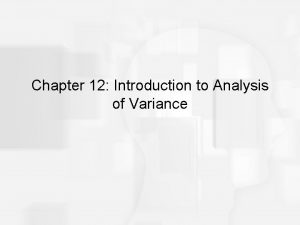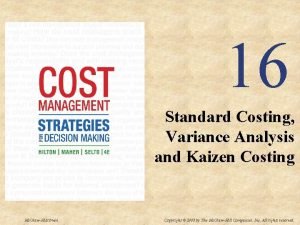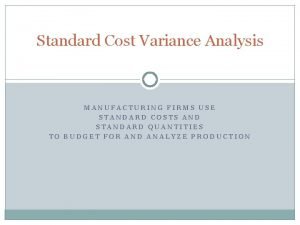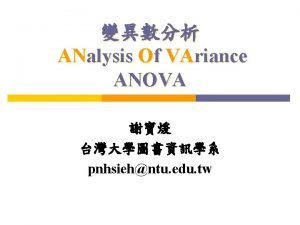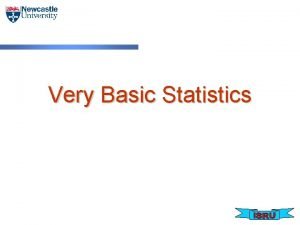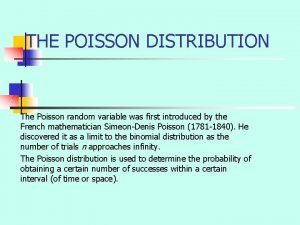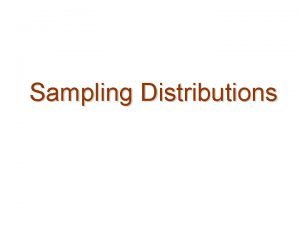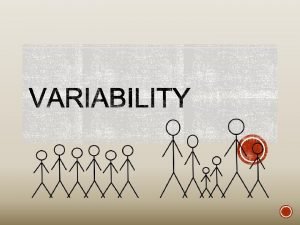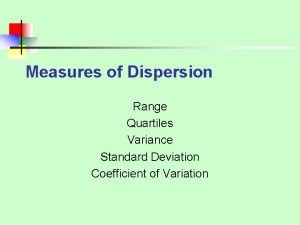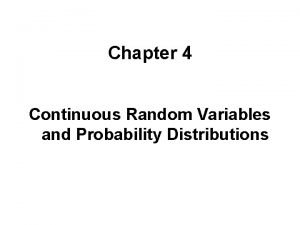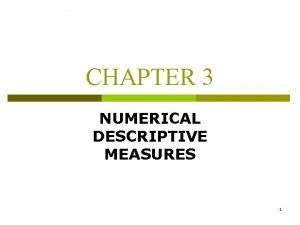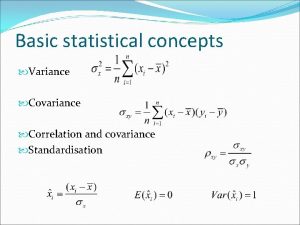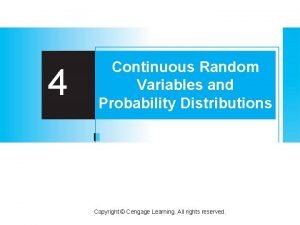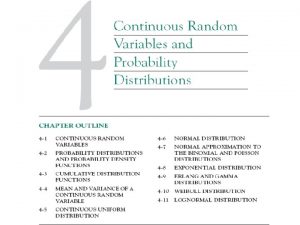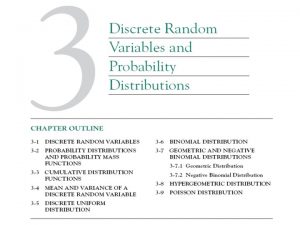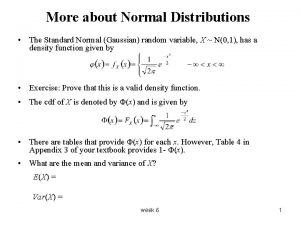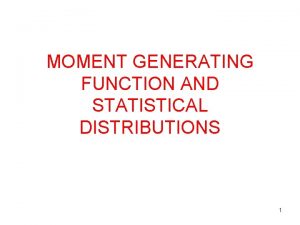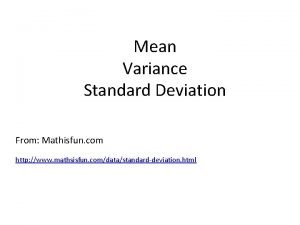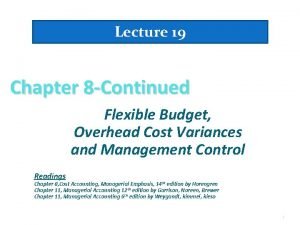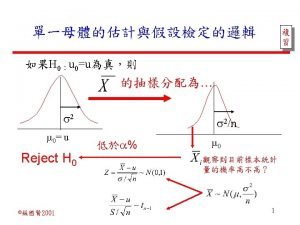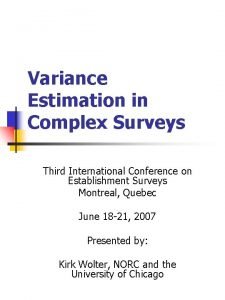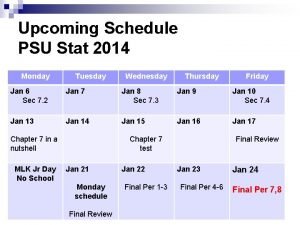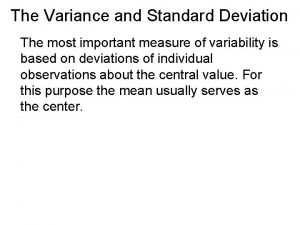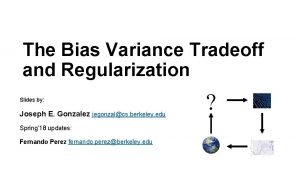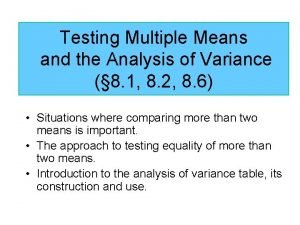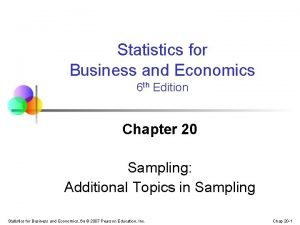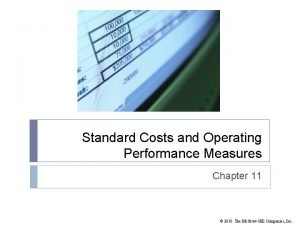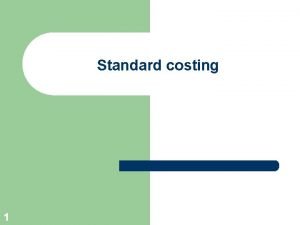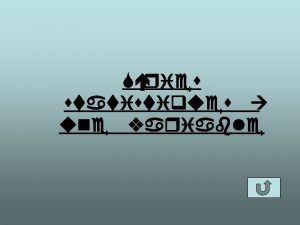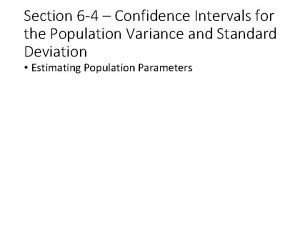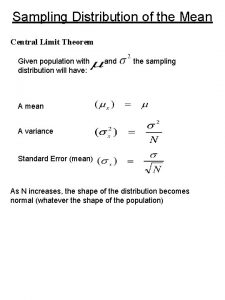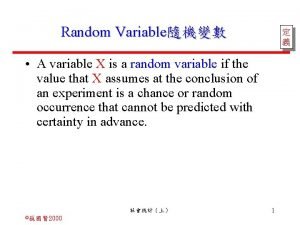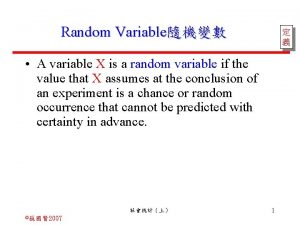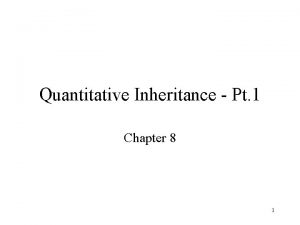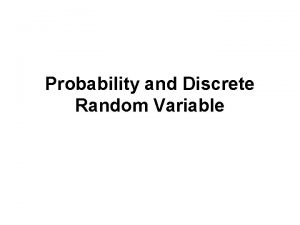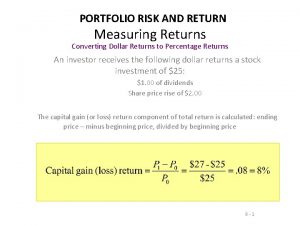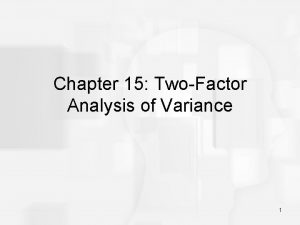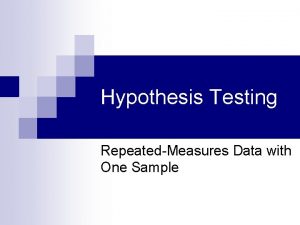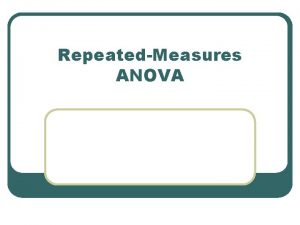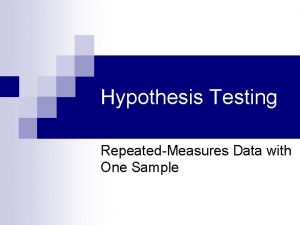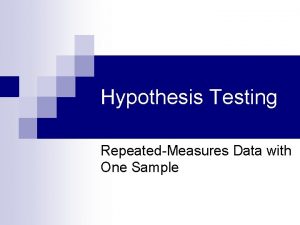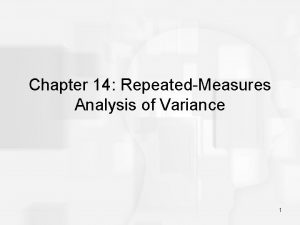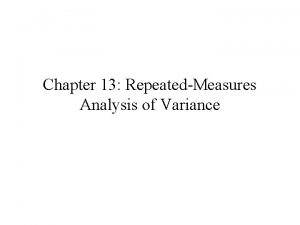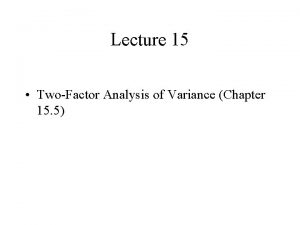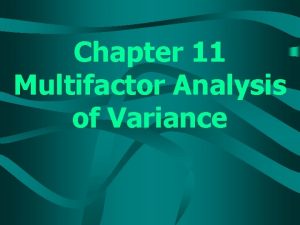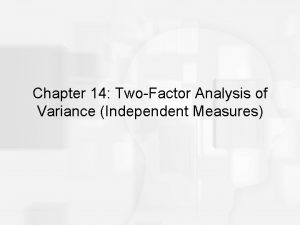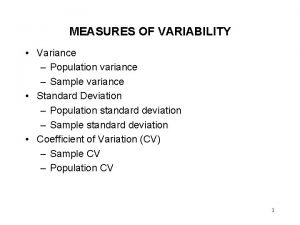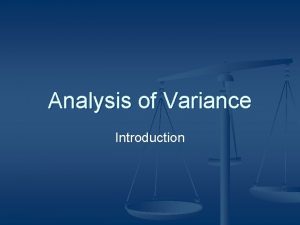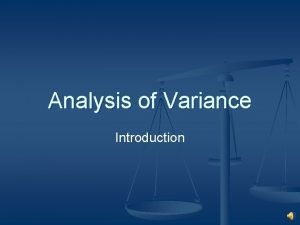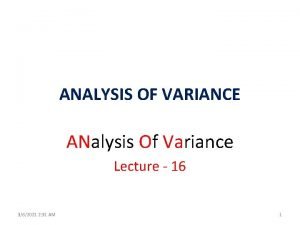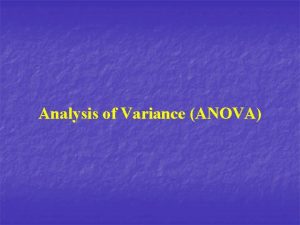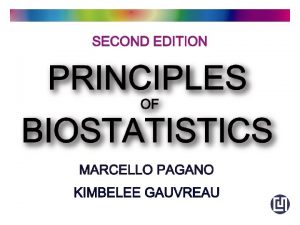Chapter 13 RepeatedMeasures and TwoFactor Analysis of Variance























































- Slides: 55

Chapter 13 Repeated-Measures and Two-Factor Analysis of Variance Power. Point Lecture Slides Essentials of Statistics for the Behavioral Sciences Eighth Edition by Frederick J. Gravetter and Larry B. Wallnau

Chapter 13 Learning Outcomes 1 • Understand logic of repeated-measures ANOVA study 2 • Compute repeated-measures ANOVA to evaluate mean differences for single-factor repeated-measures study 3 • Measure effect size, perform post hoc tests and evaluate assumptions required for single-factor repeated-measures ANOVA

Ch 13 Learning Outcomes (continued) 4 • Understand logic of two-factor study and matrix of group means 5 • Describe main effects and interactions from pattern of group means in two-factor ANOVA 6 • Compute two-factor ANOVA to evaluate means for two-factor independent-measures study 7 • Measure effect size, interpret results and articulate assumptions for two-factor ANOVA

Tools You Will Need • Independent-Measures Analysis of Variance (Chapter 12) • Repeated-Measures Designs (Chapter 11) • Individual Differences

13. 1 Overview • Analysis of Variance – Evaluated mean differences for two or more groups – Limited to one independent variable (IV) • Complex Analysis of Variance – Samples are related; not independent (Repeated-measures ANOVA) – Two independent variables are manipulated (Factorial ANOVA; only Two-Factor in this text)

13. 2 Repeated-Measures ANOVA • Independent-measures ANOVA uses multiple participant samples to test the treatments • Participant samples may not be identical • If groups are different, what was responsible? – Treatment differences? – Participant group differences? • Repeated-measures solves this problem by testing all treatments using one sample of participants

Repeated-Measures ANOVA • Repeated-Measures ANOVA used to evaluate mean differences in two general situations – In an experiment, compare two or more manipulated treatment conditions using the same participants in all conditions – In a nonexperimental study, compare a group of participants at two or more different times • Before therapy; After therapy; 6 -month follow-up • Compare vocabulary at age 3, 4 and 5

Repeated-Measures ANOVA Hypotheses • Null hypothesis: in the population there are no mean differences among the treatment groups • Alternate hypothesis: there is one (or more) mean differences among the treatment groups H 1: At least one treatment mean μ differs from another

General structure of the ANOVA F-Ratio • F ratio based on variances – Numerator measures treatment mean differences – Denominator measures treatment mean differences when there is no treatment effect – Large F-ratio greater treatment differences than would be expected with no treatment effects

Individual differences • Participant characteristics may vary considerably from one person to another • Participant characteristics can influence measurements (Dependent Variable) • Repeated measures design allows control of the effects of participant characteristics – Eliminated from the numerator by the research design – Must be removed from the denominator statistically

Structure of the F-Ratio for Repeated-Measures ANOVA The biggest change between independentmeasures ANOVA and repeated-measures ANOVA is the addition of a process to mathematically remove the individual differences variance component from the denominator of the F-ratio

Repeated-Measures ANOVA Logic • Numerator of the F ratio includes – Systematic differences caused by treatments – Unsystematic differences caused by random factors are reduced because the same individuals are in all treatments • Denominator estimates variance reasonable to expect from unsystematic factors – Effect of individual differences is removed – Residual (error) variance remains

Figure 13. 1 Structure of the Repeated-Measures ANOVA

Repeated-Measures ANOVA Stage One Equations

Two Stages of the Repeated. Measures ANOVA • First stage – Identical to independent samples ANOVA – Compute SStotal, SSbetween treatments and SSwithin treatments • Second stage – Done to remove the individual differences from the denominator – Compute SSbetween subjects and subtract it from SSwithin treatments to find SSerror (also called residual)

Repeated-Measures ANOVA Stage Two Equations

Degrees of freedom for Repeated-Measures ANOVA dftotal = N – 1 dfwithin treatments = Σdfinside each treatment dfbetween treatments = k – 1 dfbetween subjects = n – 1 dferror = dfwithin treatments – dfbetween subjects

Mean squares and F-ratio for Repeated-Measures ANOVA

F-Ratio General Structure for Repeated-Measures ANOVA

Effect size for the Repeated-Measures ANOVA • Percentage of variance explained by the treatment differences • Partial η 2 is percentage of variability that has not already been explained by other factors or

In the Literature • Report a summary of descriptive statistics (at least means and standard deviations) • Report a concise statement of the ANOVA results – E. g. , F (3, 18) = 16. 72, p<. 01, η 2 =. 859

Repeated Measures ANOVA post hoc tests (posttests) • Significant F indicates that H 0 (“all populations means are equal”) is wrong in some way • Use post hoc test to determine exactly where significant differences exist among more than two treatment means – Tukey’s HSD and Scheffé can be used – Substitute SSerror and dferror in the formulas

Repeated-Measures ANOVA Assumptions • The observations within each treatment condition must be independent • The population distribution within each treatment must be normal • The variances of the population distribution for each treatment should be equivalent

Learning Check • A researcher obtains an F-ratio with df = 2, 12 in a repeated-measures study ANOVA. How many subjects participated in the study? A • 15 B • 14 C • 13 D • 7

Learning Check - Answer • A researcher obtains an F-ratio with df = 2, 12 in a repeated-measures study ANOVA. How many subjects participated in the study? A • 15 B • 14 C • 13 D • 7

Learning Check • Decide if each of the following statements is True or False T/F • For the repeated-measures ANOVA, degrees of freedom for SSerror could be written as [(N–k) – (n– 1)] T/F • The first stage of the repeatedmeasures ANOVA is the same as the independent-measures ANOVA

Learning Check - Answer True • dferror = dfw/i treatments – dfbetwn subjects • Within treatments df = N-k; between subjects df = n-1 True • After the first stage analysis, the second stage analysis adjusts for individual differences

Repeated-Measures ANOVA Advantages and Disadvantages • Advantages of repeated-measures designs – Individual differences among participants do not influence outcomes – Smaller number of participants needed to test all the treatments • Disadvantages of repeated-measures designs – Some (unknown) factor other than the treatment may cause participant’s scores to change – Practice or experience may affect scores independently of the actual treatment effect

13. 3 Two-Factor ANOVA • Both independent variables and quasiindependent variables may be employed as factors in Two-Factor ANOVA • An independent variable (factor) is manipulated in an experiment • A quasi-independent variable (factor) is not manipulated but defines the groups of scores in a nonexperimental study

13. 3 Two-Factor ANOVA • Factorial designs – Consider more than one factor • We will study two-factor designs only • Also limited to situations with equal n’s in each group – Joint impact of factors is considered • Three hypotheses tested by three F-ratios – Each tested with same basic F-ratio structure

Main Effects • Mean differences among levels of one factor – Differences are tested for statistical significance – Each factor is evaluated independently of the other factor(s) in the study

Interactions Between Factors • The mean differences between individuals treatment conditions, or cells, are different from what would be predicted from the overall main effects of the factors • H 0: There is no interaction between Factors A and B • H 1: There is an interaction between Factors A and B

Interpreting Interactions • Dependence of factors – The effect of one factor depends on the level or value of the other – Sometimes called “non-additive” effects because the main effects do not “add” together predictably • Non-parallel lines (cross, converge or diverge) in a graph indicate interaction is occurring • Typically called the A x B interaction

Figure 13. 2 Group Means Graphed without (a) and with (b) Interaction

Structure of the Two-Factor Analysis of Variance • Three distinct tests – Main effect of Factor A – Main effect of Factor B – Interaction of A and B • A separate F test is conducted for each • Results of one are independent of the others

Two Stages of the Two-Factor Analysis of Variance • First stage – Identical to independent samples ANOVA – Compute SStotal, SSbetween treatments and SSwithin treatments • Second stage – Partition the SSbetween treatments into three separate components: differences attributable to Factor A; to Factor B; and to the Ax. B interaction

Figure 13. 3 Structure of the Two-Factor Analysis of Variance

Stage One of the Two-Factor Analysis of Variance

Stage Two of the Two Factor Analysis of Variance • This stage determines the numerators for the three F-ratios by partitioning SSbetween treatments

Degrees of freedom for Two-Factor ANOVA dftotal = N – 1 dfwithin treatments = Σdfinside each treatment dfbetween treatments = k – 1 df. A = (number of rows) – 1 df. B = (number of columns)– 1 dferror = dfwithin treatments – dfbetween subjects

Mean squares and F-ratios for the Two-Factor ANOVA

Two-Factor ANOVA Summary Table Example F. 05 (1, 20) = 4. 35* F. 01 (1, 20) = 8. 10** Source SS df MS F 200 3 Factor A 40 1 40 4 Factor B 60 1 60 *6 Ax. B 100 1 100 **10 Within Treatments 300 20 10 Total 500 23 Between treatments (N = 24; n = 6)

Two-Factor ANOVA Effect Size • η 2, is computed to show the percentage of variability not explained by other factors

In the Literature • Report mean and standard deviations (usually in a table or graph due to the complexity of the design) • Report results of hypothesis test for all three terms (A & B main effects; A x B interaction) • For each term include F, df, p-value & η 2 • E. g. , F (1, 20) = 6. 33, p<. 05, η 2 =. 478

Interpreting the Results • Focus on the overall pattern of results • Significant interactions require particular attention because even if you understand the main effects, interactions go beyond what main effects alone can explain. • Extensive practice is typically required to be able to clearly articulate results which include a significant interaction

Figure 13. 4 Sample means for Example 13. 4

Two-Factor ANOVA Assumptions • The validity of the ANOVA presented in this chapter depends on three assumptions common to other hypothesis tests – The observations within each sample must be independent of each other – The populations from which the samples are selected must be normally distributed – The populations from which the samples are selected must have equal variances (homogeneity of variance)

Learning Check • If a two-factor analysis of variance produces a statistically significant interaction, then you can conclude that _____ A • either the main effect for factor A or the main effect for factor B is also significant B • neither the main effect for factor A nor the main effect for factor B is significant C • both the man effect for factor A and the main effect for factor B are significant D • the significance of the main effects is not related to the significance of the interaction

Learning Check - Answer • If a two-factor analysis of variance produces a statistically significant interaction, then you can conclude that _____ A • either the main effect for factor A or the main effect for factor B is also significant B • neither the main effect for factor A nor the main effect for factor B is significant C • both the man effect for factor A and the main effect for factor B are significant D • the significance of the main effects is not related to the significance of the interaction

Learning Check • Decide if each of the following statements is True or False T/F • Two separate single-factor ANOVAs provide exactly the same information that is obtained from a two-factor analysis of variance T/F • A disadvantage of combining 2 factors in an experiment is that you cannot determine how either factor would affect participants’ scores if it were examined in an experiment by itself

Learning Check - Answers False • Main effects in Two-Factor ANOVA are identical to results of two One-Way ANOVAs; but Two-Factor ANOVA provides Interaction results too! False • The two-factor ANOVA allows you to determine the effect of one variable controlling for the effect of the other

Figure 13. 5 Independent. Measures Two-Factor Formulas

Figure 13. 6 Example 13. 1 SPSS Output for Repeated-Measures

Figure 13. 7 Example 13. 4 SPSS Output for Two-Factor ANOVA

Equations? Concepts? Any Questions ?
 Twofactor authentication
Twofactor authentication Material yield variance formula
Material yield variance formula Standard costing and variance analysis formulas
Standard costing and variance analysis formulas Multivariate analysis of variance and covariance
Multivariate analysis of variance and covariance Standard costing and variance analysis
Standard costing and variance analysis Flexible budget variance example
Flexible budget variance example Analysis of variance and covariance
Analysis of variance and covariance Material price variance
Material price variance What is a static budget
What is a static budget The variance analysis cycle:
The variance analysis cycle: Tr
Tr Manova definition
Manova definition Variance analysis
Variance analysis Variance analysis definition
Variance analysis definition Spss mixed model
Spss mixed model Variance analysis in nursing
Variance analysis in nursing Introduction to analysis of variance
Introduction to analysis of variance General model for variance analysis
General model for variance analysis Dawson toys ltd
Dawson toys ltd Variance analysis
Variance analysis Mancova example
Mancova example Advantages of standard deviation
Advantages of standard deviation Variance and standard deviation formula
Variance and standard deviation formula Poisson distribution example
Poisson distribution example Sample proportion
Sample proportion What is a quantitative measure of variability
What is a quantitative measure of variability Statistics coefficient of variation
Statistics coefficient of variation Suppose that the log-ons to a computer network
Suppose that the log-ons to a computer network Variance standard deviation formula
Variance standard deviation formula Variance and correlation
Variance and correlation Mean and variance of gamma distribution
Mean and variance of gamma distribution Mean of exponential distribution formula
Mean of exponential distribution formula Discrete uniform distribution
Discrete uniform distribution Gaussian function
Gaussian function Moment generating function of geometric distribution
Moment generating function of geometric distribution Standard deviation
Standard deviation Fixed overhead capacity variance formula
Fixed overhead capacity variance formula Variance expected value
Variance expected value Estimator of variance
Estimator of variance Statistics symbols
Statistics symbols Variance of sample
Variance of sample Bias variance tradeoff
Bias variance tradeoff H test
H test What is proportional allocation
What is proportional allocation Fixed overhead volume variance
Fixed overhead volume variance Variance reconciliation statement
Variance reconciliation statement Mdiane
Mdiane Confidence interval for population variance formula
Confidence interval for population variance formula Mean of sampling distribution
Mean of sampling distribution Variance of the random variable
Variance of the random variable Variance of the random variable
Variance of the random variable Components of genetic variation
Components of genetic variation Narrow sense heritability vs broad sense heritability
Narrow sense heritability vs broad sense heritability What is binomial distribution
What is binomial distribution Portfolio variance
Portfolio variance Variance of 3 asset portfolio formula
Variance of 3 asset portfolio formula


